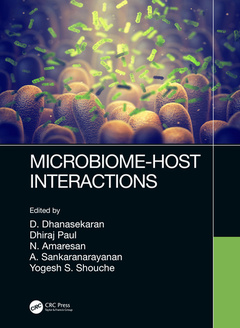Description
Microbiome-Host Interactions
Coordinators: Dhanasekaran D., Paul Dhiraj, Amaresan N., Sankaranarayanan A., Shouche Yogesh S.
Language: English
Subjects for Microbiome-Host Interactions:
Keywords
Microbiome Host Interactions; Polar soil environment; 16S rRNA Gene Amplicon Sequencing; Agroecosystem; Fungal Microbiome; Microbiome-host interactions; Sea Water; Caenorhabditis elegans; Shallow Hydrothermal Vents; Actinorhizal root nodules; Gut Microbiota; Plant Microbiome; Gut Microbiome; OTU Table; Faecalibacterium Prausnitzii; Amplify Ribosomal DNA Restriction Analysis; Vaginal Microbiome; Rhizosphere Microbiome; Culture Dependent Studies; Archaeal Community Composition; Microbiome Data; Abundant Bacterial Phyla; Vaginal Microbiota; Microbial Communities; Mangrove Sediment; Mangrove Ecosystem; Endophytic Fungi; Core Microbiota; Soil Microbiome; Hydrothermal Vents
· 21x28 cm · Hardback
Description
/li>Contents
/li>Readership
/li>Biography
/li>
Microbiota are a promising and fascinating subject in biology because they integrate the microbial communities in humans, animals, plants, and the environment. In humans, microbiota are associated with the gut, skin, and genital, oral, and respiratory organs. The plant microbial community is referred to as "holobiont," and it is influential in the maintenance and health of plants, which themselves play a role in animal health and the environment.
The contents of Microbiome-Host Interactions cover all areas as well as new research trends in the fields of plant, animal, human, and environmental microbiome interactions. The book covers microbiota in polar soil environments, in health and disease, in Caenorhabditis elegans, and in agroecosystems, as well as in rice root and actinorhizal root nodules, speleothems, and marine shallow-water hydrothermal vents.
Moreover, this book provides comprehensive accounts of advanced next-generation DNA sequencing, metagenomic techniques, high-throughput 16S rRNA sequencing, and understanding nucleic acid sequence data from fungal, algal, viral, bacterial, cyanobacterial, actinobacterial, and archaeal communities using QIIME software (Quantitative Insights into Microbial Ecology).
FEATURES
- Summarizes recent insight in microbiota and host interactions in distinct habitats, including Antarctic, hydrothermal vents, speleothems, oral, skin, gut, feces, reproductive tract, soil, root, root nodules, forests, and mangroves
- Illustrates the high-throughput amplicon sequencing, computational techniques involved in the microbiota analysis, downstream analysis and visualization, and multivariate analysis commonly used for microbiome analysis
- Describes probiotics and prebiotics in the composition of the gut microbiota, skin microbiome impact in dermatologic disease prevention, and microbial communities in the reproductive tract of humans and animals
- Presents information in a reachable way for students, teachers, researchers, microbiologists, computational biologists, and other professionals who are interested in strengthening or enlarging their knowledge about microbiome analysis with next-generation DNA sequencing in the different branches of the sciences
1. An Insight of Microbiome Science Section I: Omics and Computational Techniques Used for Microbiome Analysis 2. Multi-Omics: Overview, Challenges, and Applications 3. Computational Techniques Used for Microbial Diversity Analysis 4. Downstream Analysis and Visualization-Knowledge Discovery – Alpha and Beta Diversity 5. Biostatistics Including Multivariate Analysis Commonly Used for Microbiome Analysis/Study Section II: Human Microbiome 6. Structure and Functional Role of Microbiome Associated with Specific Organs of Healthy Individuals 7. Structure and Function of Healthy Human Microbiome: Role in Health and Disease 8. Human Microbiome’s Role in Disease 9. Role of Human Gut Microbiome in Health and Disease 10. The Role of Probiotics and Prebiotics in the Composition of the Gut Microbiota and Their Influence on Inflammatory Bowel Disease, Obesity, and Diabetes 11. Skin Microbiome, Its Impact on Dermatological Diseases, and Intervention of Probiotics 12. Role of Dysregulation of the Human Oral and Gastrointestinal Microbiome in Chronic Inflammatory Disease 13. Microbiome in Women Reproductive Health 14. Crosstalk between Bacteria and Host Immune System with Special Emphasis on Foodborne Pathogens Section III: Animal Microbiome 15. Reproductive Tract Microbiome in Animals: Physiological versus Pathological Condition 16. Community Structures of Fecal Actinobacteria in Animal Gastrointestinal System 17. Microbiota Functions in Caenorhabditis elegans 18. Impact of Microbial Communities on the Female Reproductive Tract of Bovine Section IV: Plant Microbiome 19. Insights into the Structure, Function, and Dynamics of Rice Root and Rhizosphere-Associated Microbiome 20. Mangrove Ecosystem and Microbiome 21. Role of the Mycobiome in Agroecosystems 22. Root Nodule Microbiome from Actinorhizal Casuarina Plant 23. Growth Promotion Utility of the Plant Microbiome Section V: Environmental Microbiome 24. Microbiome of Speleothems – Secondary Mineral Deposits 25. Microbiome of Marine Shallow-Water Hydrothermal Vents 26. Diversity and Bioprospecting Potentials of Antarctic (Polar) Microbes 27. Alterations in Microbial Community Structure and Function in Response to Azo Dyes 28. Soil Microbiome
D. Dhanasekaran is an Associate Professor in the Department of Microbiology, School of Life Sciences, Bharathidasan University, Tiruchirappalli, India. He has experience in the fields of actinobacteriology and mycology. His current research focuses on microbiome profiling of actinorhizal root nodules, lichen, poultry gut, and cattle reproductive system. He was awarded UGC-Raman Postdoctoral Fellowship and worked in the Department of Molecular, Cellular, and Biomedical Sciences at the University of New Hampshire, Durham, USA. He has qualified the Tamil Nadu State Eligibility Test (SET) for Lectureship in Life Science. He has deposited around 106 nucleotide sequences and 7 metagenome sequences; drafted genome sequence of Blastococcus sp. CT_GayMR20 in GenBank and five bioactive compounds in PubChem; and published 105 research and review articles—including one paper in Nature Group Journal Scientific Report—and 23 book chapters. He has an h-index of 25 with total citations of 1995 as per Google Scholar. He has edited seven books on Antimicrobial Compounds: Synthetic and Natural Compounds, Microbial Control of Vector Borne Diseases, Fermented Food Products, CRC Press, Taylor & Francis Group, New York, Fungicides for Plant and Animal Diseases, Actinobacteria: Basics and Biotechnological Applications, Algae-Organisms for Imminent Biotechnology, Microbial Biofilms – Importance and Applications under in-tech open access publisher Eastern Europe. He has guided 12PhD candidates and organized several national-level symposia, conference, and workshop programs. He has received research funding from the Department of Biotechnology, University Grant Commission, Indian Council for Medical Research and International Foundation for Science, Sweden; International Society for Microbial Ecology, The Netherlands; and Tamil Nadu State Council for Science and Technology. He is a member of the American Society for Microbiology, North Amer




